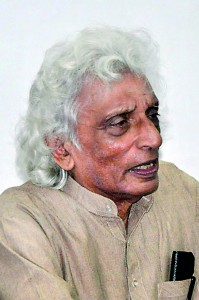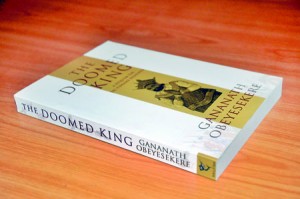A royal redemption
The name of Sri Lanka’s last king Sri Vikrama Rajasinha, more often than not, conjures up images of a cruel and tyrannical man, remembered more for his abominable cruelty than as a just ruler. And this is not without reason.

Gananath Obeyesekere: On a mission. Pix by Nilan Maligaspe
The vivid images that have been created in the minds of people by the tales of Sri Vikrama’s tyranny told for over two centuries have left the line between fact and myth blurred.Hence any attempt to paint Sri Vikrama Rajasinha in afavourable light is not an easy task but it is one that has been undertaken with zeal by Gananath Obeyesekere in his recently released book, ‘ The Doomed King – A requiem for Sri Vikrama Rajasinha’.
It all started a few years ago when Obeyesekera, Emeritus Professor of Anthropology at Princeton University, was on a stroll around the Kandy Lake. “As I was walking along the Lake, I saw on the other side a hotel with an emblem with the British lion. My immediate reaction was there is something really wrong here. Here you have the magnificent lake created by King Sri Vikrama who has always had a bad press but there next door you have the British Lion. So that sort of created some sort of curiosity as to what was going on here. I think that led to some kind of provocation for getting more information on this king,” Obeyesekere said.
In his book, he describes the deposing of Sri Vikrama, who ruled from 1798-1815 as “probably the most momentous event in Sri Lanka’s history.” Sri Vikrama was captured by the British in February of 1815 and banished to Vellore in South India where he died as a prisoner in 1832. The Kandyan Convention was signed a month later giving control over the entire island to the British.”
To put the record straight, so to speak, on a much maligned monarch, Obeyesekera started by collecting information by reading old texts, some of which were quite unknown before as well as studying various types of oral literature among many other sources. The more information he gathered, the more convinced Obeyesekere was that Sri Vikrama was a victim of a well hatched plot by the British to oust him from power and take control of the Kandyan provinces.
And in the thick of this plot is John D’Oyly; the man who played the leading role in discrediting the King by way of false propaganda and by using disgruntled members of the Kandyan aristocracy to work against Sri Vikrama, which eventually led to the King’s capture and banishment.
Obeyesekera comes down hard on D’Oyly which puts him at odds with many other eminent writers on their interpretation of the Englishman whom they have chosen to view as a historian or a scholar. For Obeyesekere he is a “master spy”.
“D’ Oyly the spy systematically undermined the integrity of the King by securing major officials to work against him, eroding the king’s authority through insidious propaganda and portrayed him as an alien, a cruel and oppressive person who had no moral right to sovereignty,” Obeyesekera writes.
He is also harsh on Ahelepola who became the First Adigar after the execution of Pilimatalava in 1811. Ahelepola became one of D’Oyly’s main sources of information till he fled from Kandy fearing persecution at the hands of Sri Vikrama. Obeyesekere says in his book, “Ahelepola foolishly believed that he would be crowned king after Rajasinha was deposed and was secured by what he imagined was D’Oyly’s friendship whereas for the former, friendship was subordinated to his commitment to Britain.”
Ahelepola fleeing to British territory in turn led to one of the most notorious incidents in Lankan history- the slaughter of his wife Kumarihami and children and the infamous “pounding episode”.
Obeyesekere argues that while the execution of Ahelepola’s family was cruel, it was legitimate “in Kandyan law”. “The kinsfolk of someone accused of treason can be held hostage and if the treacherous person does not return, then his kin can be executed. It was a terrible law and one that Ahelepola as the Principal Minister of First Adigar surely knew well,” Obeyesekere says.
“One of the worst crimes is to betray the king, both in the Sinhala tradition and the British tradition. The King had his bad points but he was a decent monarch,”Obyeyesekera says.
He also puts the incident in context of the time when the cruel practices attributed to Sri Vikrama are no different to the punishment meted out to those who betrayed their rulers in Europe and scoffs at British attempts to look self-righteous in condemning Sri Vikrama. “The European world of that time was a world of violence and bloodshed and it needed a great deal of self-deception to say that the British of 1815 were the exemplar of tolerance and humanity, as the British like to represent them.”
Amidst all the “bad press”, what has been largely overlooked are the good deeds of Sri Vikrama.
“The King was a compulsive builder of ponds, lakes and gardens but his name has been wiped out in relation to these deeds. The Kandy Lake, the Pattirippuwa (Octagon) at the Dalada Maligawa and the (Peradeniya) Botanical Gardens were some of his feats,” Obeyesekera says.
“The Gardens are called the Royal Botanical Gardens but I have said time and again it should be named after Sri Vikrama – the man who initiated the process of making it a botanical garden,” he says.
Obeyesekere hopes his book will provide impetus to a new generation of scholars to take a fresh look at the life of a much maligned king in Sri Lanka’s history. “You cannot convert the world but I hope this book will at least get some people thinking,” Obeyesekere says.


